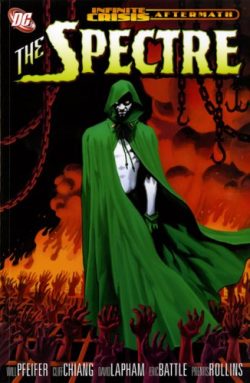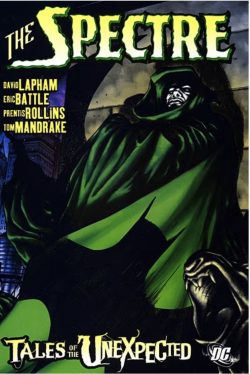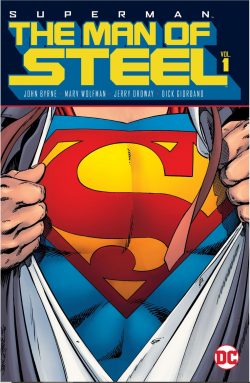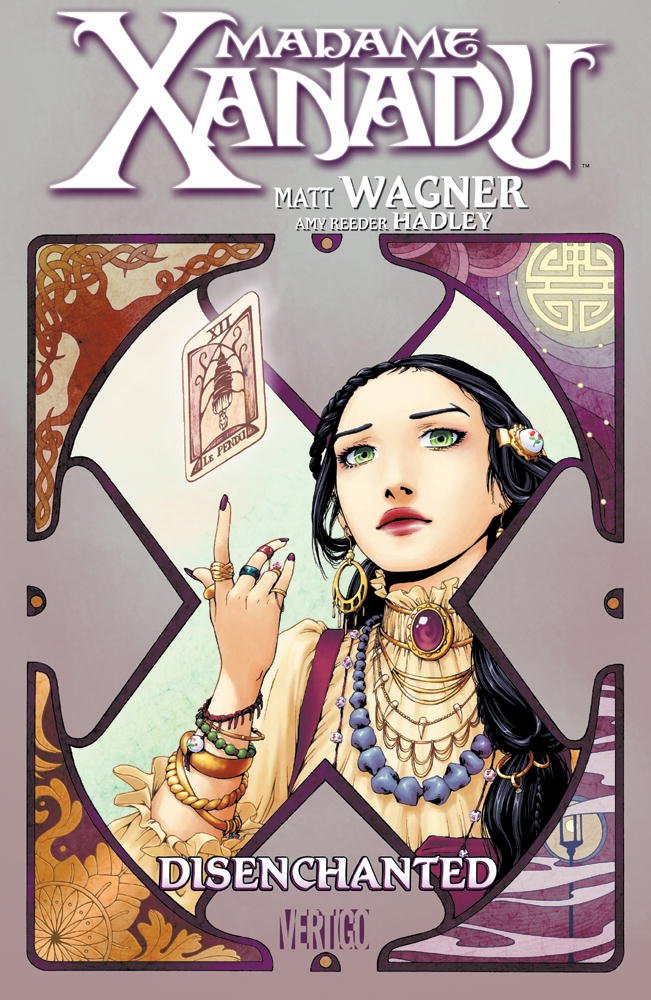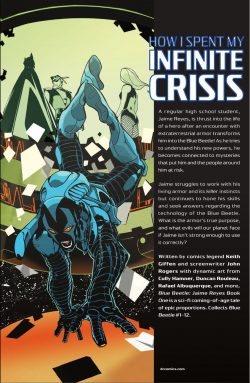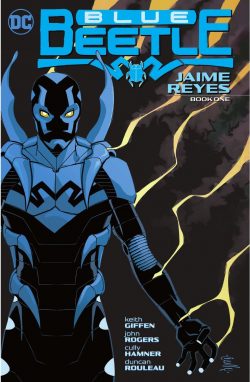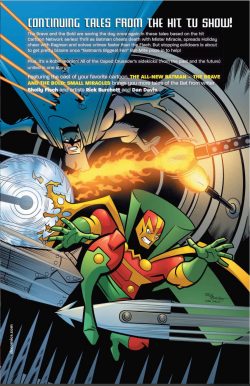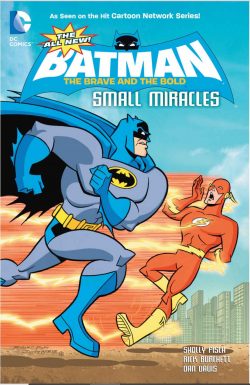
By Bob Haney, Cary Burkett, Martin Pasko, Dave Michelinie, Len Wein, Cary Bates, Steve Englehart, Paul Levitz, Jim Aparo, José Luis García-López, Murphy Anderson, Curt Swan, Dick Dillin, Joe Staton, Rich Buckler, Don Newton, Romeo Tanghal, Frank McLaughlin, Frank Chiaramonte, Dick Giordano, Jack Abel, Bob Smith & various (DC Comics)
ISBN: 978-1-79950-082-7 (TPB)
This book includes Discriminatory Content produced in less enlightened times
Here’s another stunning and timely compilation comprising the best of vintage comics; one more astounding and epic DC Finest edition. These weighty, full colour treasure troves are chronologically curated themed tomes highlighting past glories from the company that invented superheroes and so much more. Sadly, they’re not yet available digitally, as were the last decade’s Bronze, Silver and Golden Age collections, but we live in hope…
As you’ve probably noticed, a big part of superhero fiction involves interacting – if not always uniting – with other costumed stars. Every producer, purveyor and publisher of Fights ‘n’ Tights fare employs and exploits the concept of allied action and chums in conflict, with apparently every consumer insatiably coveting them and more of the same. With The Man of Steel and a whole bunch of super-suited & booted associates happily and profitably cavorting across big screens everywhere now, let’s look at a few of his past collaborations… and while we’re at it, peek at some of his best pal’s other playmates at the same time…
From the moment a kid first sees his second superhero the only thing he/she wants is to observe how the new gaudy gladiator stacks up against the first. From the earliest days of the comics industry – and according to DC Comics Presents first editor Julie Schwartz, it was the same with the pulps and dime novels that preceded it – we’ve wanted our idols to meet, associate, battle together (and if you follow the Timely/Marvel model, that means against each other) far more than we want to see them trounce their archenemies in a united front…
The concept of team-up comic books – an established star pairing or battling (usually both) with less well-selling company characters – was far from new when DC awarded their then-biggest gun (it was the publicity-drenched weeks before the release of Superman: The Movie and Tim Burton’s Batman was over a decade away) a regular arena to share adventures with other stars of their firmament, just as Batman had been doing since the middle of the 1960s.
The Brave and the Bold began in 1955 as an anthology adventure comic featuring short tales of period heroes: a format mirroring contemporary movie fascination with historical dramas. Written by Bob Kanigher, issue #1 led with Golden Gladiator, the Silent Knight and Joe Kubert’s now legendary Viking Prince. From #5 the Gladiator was increasingly alternated with Robin Hood, and manly, mainly mainstream romps carried the title until the end of the decade when the burgeoning costumed character revival saw B&B transform into a try-out vehicle like sister publication Showcase.
Brave and the Bold #25 (August/September 1959) debuted Task Force X: Suicide Squad, followed by Justice League of America (#28), Cave Carson (#31) and Hawkman (#34). Since only the JLA hit first time out, there were return engagements for the Squad, Carson and Hawkman. Something truly different appeared in #45-49 with science fictional Strange Sports Stories before B&B #50 triggered a new concept that once again truly caught reader imaginations.
It paired superheroes Green Arrow and Martian Manhunter in a one-off team-up, as did succeeding issues: Aquaman and Hawkman in #51, WWII wonders Sgt. Rock, Captain Cloud, Mme. Marie and the Haunted Tank in #52 and Atom with Flash in #53. The next team-up – Robin, Aqualad & Kid Flash – swiftly evolved into the Teen Titans. After Metal Men/the Atom and Flash/Martian Manhunter, new hero Metamorpho, the Element Man debuted in #57-58. Then it was back to superhero pairings with #59, and although no one realised it at the time this particular conjunction (Batman & Green Lantern) would be particularly significant. Soon the book would become a vehicle for Batman team-ups…
With the 1978 release of Superman The Movie it was time to reward the Man of Tomorrow with a similar dedicated publication, although in truth, the Action Ace had already enjoyed the sharing experience once before, when World’s Finest Comics briefly ejected the Caped Crusader and Superman paired with a coterie of heroes including Flash, Robin, Aquaman, Teen Titans, Vigilante, Dr. Fate and others (i#198-214; cover-dated November 1970 to October/November 1972) before the traditional status quo was re-established.
This superb all action collection intriguingly re-presents the first 14 star-studded monthly DC Comics Presents releases and the equivalent contemporary issues of The Brave and the Bold – #141-155). These together collectively span May/June 1978 through October 1979. We open with B&B and resident creators Bob Haney & Jim Aparo, so before the off here’s some background.
Robert Gilbert Haney, Jr. was born on 15th March 1926, growing up in Philadelphia listening to radio dramas and serials, and reading newspaper strips like Prince Valiant and Flash Gordon. Higher education at Swathmore College led to service in the US Navy. He was one of the lucky ones to survive The Battle of Okinawa relatively unscathed.
Follow up studies at Columbia University led to a Master’s degree, after which Haney began a prolific storytelling career by writing a slew of popular novels under a number of noms de plume. In 1947, he moved sideways into comic books, beginning with racy tale ‘College for Murder’ in Harvey Comics’ Black Cat #9 (cover-dated January 1948). From then until 1955 he freelanced for various publishers like Fawcett, Hillman, Standard and St. John on genre tales packed with action, grit and wit.
When anti-comics witch-hunts in the 1950s led to a bowdlerising, self-inflicted Comics Code, Haney shifted gears and began an almost exclusive position as a scripter at DC/National Comics, initially for the war comic division. His first sale was ‘Frogmen’s Secret’ in All American Men of War #17 (January 1955), and he scripted the very first Sgt Rock story in 1959, and countless more for all the combat titles.
Immensely versatile, he wrote for every genre division from licensed to humour, western to superhero and for titles including Blackhawk, Adventures of Rex the Wonder Dog, Sea Devils, Tomahawk, Challengers of the Unknown, Superman’s Pal Jimmy Olsen, My Greatest Adventure, Doom Patrol, Aquaman, Hawkman, Space Ranger, Green Arrow, Deadman, The Unknown Soldier, and the very first Batman team-up in The Brave and the Bold #59. For decades the book would be his personal playground and where he delivered his take on most of the company’s vast pantheon…
Haney co-created the Teen Titans, Metamorpho, Eclipso, Enchantress (in Strange Adventures), Aquagirl, Cain of The House of Mystery and the Super-Sons, but ultimately his style began to clash with DC’s changing teen demographic. Happily, he had also been working in animation since the mid-1960s, scripting episodes of The New Adventures of Superman and The Superman/Aquaman Hour of Adventure TV shows; and in the 1980s, DC’s loss was cartoon kids’ gain. Haney worked extensively on new shows including Karate Kat, Silverhawks and ThunderCats, as well as producing books of general fiction and consumer journalism. Ultimately, rapprochement with a new DC management saw Haney return to comics for nostalgia-tinged titles including Elseworlds 80-Page Giant #1 (August 1999); Silver Age: The Brave and the Bold #1 (July 2000); and – posthumously published –Teen Titans Lost Annual #1 (March 2008).
Haney died on November 25th 2004, in La Mesa, California.
Taking his cues from news headlines, popular films and proven genre-sources, Haney continually produced gripping yarns that thrilled and enticed, with no need for more than a cursory nod to an ever-more-onerous continuity. Anybody could pick up an issue of B&B and be sucked into a world of wonder. Consequently, these tales are just as fresh and welcoming today, their themes and premises just as immediate now as then. Moreover, Jim Aparo’s magnificent art is still as compelling and engrossing as it always was.
James N. Aparo (August 24th 1932 – July 19th 2005) was a true but quiet giant of comic books. Self-taught, he grew up in New Britain Connecticut, and, after failing to join EC Comics whilst in his 20s, slipped easily into advertising, newspaper and fashion illustration. Even after finally becoming a comics artist he assiduously maintained his links with his first career. For most of his career he was a triple-threat, pencilling, inking and lettering his pages. In 1963 he began drawing Ralph Kanna’s newspaper strip Stern Wheeler, and three years later was working on a wide range of features for go-getting visionary editor Dick Giordano at Charlton Comics. Aparo especially shone on the minor company’s licensed top gun The Phantom. In 1968 when Giordano was lured away to National/DC he brought his top performers (primarily Steve Ditko, Steve Skeates and Aparo) with him. Aparo began a life-long association with the company where legends live illustrating and reinvigorating moribund title Aquaman – although he also continued with The Phantom until his duties grew with the addition of numerous short stories for the monolith’s burgeoning horror anthologies and revived 1950s supernatural champion The Phantom Stranger.
Aparo went on to become a multi award-winning mainstay of DC’s artistic arsenal, with stellar runs on The Spectre, The Outsiders and Green Arrow, but his star was always and forever linked to Batman’s.
In B&B #141’s ‘Pay – Or Die!’ that relationship and the artist’s versatility shines as Black Canary helps Batman quash The Joker’s byzantine extortion scheme.

Fast-paced, straightforward, done-in-one dramas almost by definition, these quick treats were perfect introducer tales and seldom carried over, but in #142, ‘Enigma of the Death-Ship!’ sees Aquaman and wife Mera battle the Dark Knight to suppress a family secret, before the sordid trail of a covert Gotham drug lord leads to the most respected man in America in the next issue, with Cary Burkett collaborating with Haney for conclusion ‘Cast the First Stone’ as manic crime-crusher The Creeper confronts his mentor and finds even the most esteemed hero can have feet of clay…
The brave, bold portion of our entertainment pauses here to allow the Metropolis Marvel his moment to shine with a debut 2-part thriller from DC Comics Presents #1 & 2 (July/August & September/October 1978), featuring Silver Age Flash Barry Allen, who had also been Superman’s first co-star in that aforementioned World’s Finest Comics run. ‘Chase to the End of Time!’ and ‘Race to the End of Time!’ by scripter Marty Pasko & utterly astounding José Luis García-López inked by Dan Adkins, rather reprises that selfsame WF tale. Here warring alien races trick both heroes into speeding relentlessly through the time-stream to prevent Earth’s history from being corrupted and destroyed. As if that isn’t dangerous enough, nobody could predict the deadly intervention of the Scarlet Speedster’s most dangerous foe, Professor Zoom, the Reverse-Flash, but the heroes sort it all out in the end…
In B&B #144 Haney& Aparo deliver a magical mystery tale of ‘The Arrow of Eternity’ as Caped Crusader and Emerald Archer head back in time to Agincourt and foil a wicked plot by time-tamperer the Gargoyle, whilst in DCCP #3, David Michelinie’s tantalising pastiche of classic Adam Strange/Mystery in Space thrillers results in a modern masterpiece for García-López to draw and ink in ‘The Riddle of Little Earth Lost’. Here Man of Two Worlds and Man of Steel foil the diabolical cosmic catastrophe scheme of deranged ex-tyrant Kaskor to transpose, subjugate and/or destroy Earth and light-years distant planet Rann.
Courtesy of Haney & Aparo, The Phantom Stranger and Batman face ‘A Choice of Dooms!’ pursuing voodoo crime lord Kaluu in B&B #145 whilst DCCP #4 welcomed Len Wein to script the superb ‘Sun-Stroke!’ for García-López, as Man of Steel and madly-malleable Metal Men join forces to thwart solar-fuelled genius I.Q. and toxic elemental menace Chemo after an ill-considered plan to enhance Earth’s solar radiation exposure provokes a cataclysmic solar-flare…
Haney and guest artists Romeo Tanghal & Frank McLaughlin switch worlds and times in B&B #146 as the Batman of World War II assists faceless superspy the Unknown Soldier in stopping Nazi assassin Count von Stauffen from murdering America’s top brass and greatest scientists to sabotage the nation’s most secret weapon project, whereas modern day Sea King Aquaman is embroiled in ‘The War of the Undersea Cities’ (by Wein, Paul Levitz & Murphy Anderson) in DCCP #5.

This time, Superman must step in after Aquaman’s subjects in Poseidonis re-open ancient hostilities with the mer-folk of undersea neighbour Tritonis, home of the caped Kryptonian’s college girlfriend Lori Lemaris. Fortunately, cooler heads prevail when the deadly Ocean Master is revealed to be meddling in their sub-sea politics…
Supergirl enjoyed her first ever B&B Bat team-up. She had previously paired with Wonder Woman in #63, in the outrageously-dated and utterly indefensible ‘Revolt of the Super-Chicks!’ but here in #147 however, Burkett & Aparo’s ‘Death-Scream from the Sky!’ sees her and the Gotham Guardian save the world from extermination by satellite and shady surprise super villain Dr. Light…
A DCCP two-parter opens with ‘The Fantastic Fall of Green Lantern’ (Levitz, Curt Swan & Francisco Chiaramonte) in #6 which sees the Man of Steel briefly inherit the awesome power ring after Hal Jordan falls in battle against his female antithesis Star Sapphire. Although triumphant against her, “Green Superman” is subsequently ambushed by warriors from antimatter universe Qward leading to ‘The Paralyzed Planet Peril!’ (#7 by Levitz, Dick Dillin & Chiaramonte) wherein those bellicose aliens seek to colonise Earth… until robotic AI hero Red Tornado swirls in to the rescue.
Back in B&B, Good Cheer mingles with Drama as ‘The Night the Mob Stole X-Mas!’ delivers seasonal fluff by Haney pencilled by Joe Staton, with Aparo applying his overpowering inks to a tale of cigarette smugglers and aging mafioso, with Plastic Man helping to provide a mandatory Christmas miracle. The disbanded Teen Titans briefly reform in #149 for Haney & Aparo’s ‘Look Homeward, Runaway!’ to help Batman hunt and redeem a kid gang moving from petty crime to the big leagues after which in DCCP #8, ‘The Sixty Deaths of Solomon Grundy’ (Steve Englehart & Murphy Anderson) teams Swamp Thing with Action Ace. At this time the bog-beast still believed he was a transformed human and not an enhanced plant, and Alec Holland searches the sewers of Metropolis for a cure to his condition, only to stumble onto a battle between the Man of Steel and the mystic zombie who was “born on a Monday”…
Anniversary event The Brave and the Bold #150 was celebrated with a pairing that was both old hat and never seen before. Haney & Aparo’s ‘Today Gotham… Tomorrow the World!’ commemorates the landmark anniversary with an extended tale of Bruce Wayne’s abduction by terrorists and the undercover superhero who secretly shadows him. No hints here from me…
In that other caped crimebuster’s book, Pasko returns to script Staton & Jack Abel’s ‘Invasion of the Ice People!’ in #9, wherein Wonder Woman assists in repelling an arctic assault by malign disembodied intellects whist in B&B #151, The Flash becomes prey and appetiser for a predatory haunt feeding off patrons at Gotham’s hippest nightspot… and Batman barely breaks the spell at the ‘Disco of Death’ (Haney & Aparo). Another 2-part tale commences with DCCP #10’s ‘The Miracle Man of Easy Company’ (Cary Bates, Staton & Abel), as a super-bomb blasts Superman back to WWII and a momentous if amnesia-tainted meeting with indomitable everyman soldier Sgt. Rock. However before the Caped Kryptonian returns home to battle a brainwashed and power-amplified Hawkman in #11’s ‘Murder by Starlight!’ (Bates, Staton & Chiaramonte) there’s an intriguing interruption. B&B #152 splits the saga as Haney & Aparo reveal ‘Death Has a Golden Grab!’. Here mighty mite The Atom helping the Gotham Gangbuster stop a deadly bullion theft. Chronologically #153 – courtesy of Burkett, Don Newton & Bob Smith – then sees Red Tornado help Batman survive old school greed and the hi-tech ‘Menace of the Murder Machines’ before DCCP #12 arranged a duel between the Man of Steel and New God Mister Miracle in ‘Winner Take Metropolis’ by Englehart, Richard Buckler & Dick Giordano.


B&B #154 finds Element Man Metamorpho treading ‘The Pathway of Doom…’ to save former girlfriend Sapphire Stagg and help Batman disconnect a middle eastern smuggling pipeline, prior to the brave, bold portion of our entertainment coming to a close with #155’s ‘Fugitive from Two Worlds!’ as Haney & Aparo detail Green Lantern Hal Jordan clashing with the Dark Knight over jurisdiction rights regarding an earthshaking alien criminal.
Closing this perfectly curated portion of comics history is another two-part tale spanning centuries as Levitz scripts an ambitious epic limned by Dillin & Giordano that begins with ‘To Live in Peace… Nevermore!’ When the Legion of Super-Heroes visit the 20th century they must prevent Superman saving a little boy from alien abduction to preserve the integrity of the time-line. It doesn’t help that the lad is Jon Ross, son of Clark Kent’s oldest friend and most trusted confidante. Furious and deranged by loss, Pete Ross risks the destruction of reality itself by enlisting the aid of Superboy to battle his older self in ‘Judge, Jury… and No Justice!’, but achieves only stalemate and a promise from the Man of Tomorrow to somehow make things right…
This titanic tome offers a tantalising snapshot of combined A-lister capers and demonstrates the breadth of DC’s roster of lesser stars in punchy, pithy adventures acting as a perfect shop window and catalogue of legendary fascinating characters – and creators. It also delivers a delightful variety of self-contained, satisfying entertainments ranging from the merely excellent all the way to utterly unmissable. DC Finest: Team-Ups is an ideal introduction to the DC Universe for every kid of any age and passport to Costumed Dramas of a simpler, more inviting time.
© 1978, 1979, 2025 DC Comics. All Rights Reserved.

